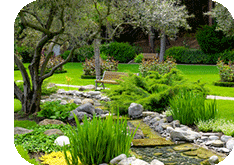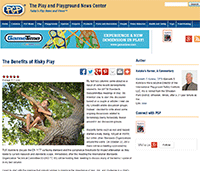Building Blocks of the Outdoor Environment Series: Plants
Author: Chad Kennedy, Landscape Architect, ASLA
 Perhaps the most versatile and complex building blocks in urban outdoor environments are plants. Plants were used in many ancient gardens to convey power and riches. They were also used in the construction of Central Park to transform a useless dumping ground into a national treasure, and they are used in Japanese gardens to foster reflection, tranquility and peace. When walking through modern urban environments I often wonder if society has forgotten about the wonderful qualities that plants bring to the environment. In many cases landscape features are an afterthought, reserved for leftover useless spaces, or filler for setbacks required by local, regional and State jurisdictions. Various characteristics of plant materials when utilized correctly, and with proper up-front planning, can create cognitively understandable spaces, invoke very real emotions, convey messages and create functional spaces. In general, plant physiological, functional and biological characteristics are evaluated and exploited by designers to meet desired objectives. General characteristics often evaluated include plant texture, form, size, aroma, color, pH tolerances, temperature preferences and water use requirements. Other characteristics related to more specific uses include food production, soil stabilization effectiveness, stormwater cleansing properties, security and sheltering qualities.
Perhaps the most versatile and complex building blocks in urban outdoor environments are plants. Plants were used in many ancient gardens to convey power and riches. They were also used in the construction of Central Park to transform a useless dumping ground into a national treasure, and they are used in Japanese gardens to foster reflection, tranquility and peace. When walking through modern urban environments I often wonder if society has forgotten about the wonderful qualities that plants bring to the environment. In many cases landscape features are an afterthought, reserved for leftover useless spaces, or filler for setbacks required by local, regional and State jurisdictions. Various characteristics of plant materials when utilized correctly, and with proper up-front planning, can create cognitively understandable spaces, invoke very real emotions, convey messages and create functional spaces. In general, plant physiological, functional and biological characteristics are evaluated and exploited by designers to meet desired objectives. General characteristics often evaluated include plant texture, form, size, aroma, color, pH tolerances, temperature preferences and water use requirements. Other characteristics related to more specific uses include food production, soil stabilization effectiveness, stormwater cleansing properties, security and sheltering qualities.
Plants are selected carefully, by reviewing their innate characteristics in order to convey a story or invoke a specific feeling within a space. For example, the plants selected for the entry to a dinosaur museum should be researched carefully to create a sense of mystery, uniqueness, wonder and amazement. This may be accomplished by using plants with large leaves, uncommon shapes and unfamiliar seeds and fruits. Large forms that help create a false sense of scale, trees with scaly or peeling bark and others characteristics may help tell a story before a patron ever enters the museum. On the other hand, an entry to a temple or place of worship will involve the selection of plants that promote meditation, contemplation and spiritual reflection. This may be accomplished through plants that, have cultural or symbolic meaning attached to them, can direct the eyes upwards toward the sky, frame views well, have clean textures and colors, emit specific aromas that relax the body or have cultural significance, and those that are dense and can screen out noise and visual clutter. Plant selections in these two scenarios are vastly different resulting in two very different landscapes. The geographic location of these landscapes will also change plant selections (often referred to as a plant palette) as not every plant is suited for the variety of conditions present in the world (soil, weather, water availability, temperatures, solar orientation).
Very specific plant use characteristics are also beneficial and may be desirable. Sensory gardens, healing gardens and landscapes outside restaurants may benefit from edible and fruit bearing plantings. In order to stabilize soils and moderate erosive forces, landscapes in areas with steep slopes, recent disturbance/fire damage, and loose soils may need plants that are resilient, can cover the ground rapidly, and that create dense networks of roots. Proper management of stormwater has also become a major component of landscapes. Plants are an integral feature of the systems that slow water flow velocities, filter water, use water and even store it. Plants used for stormwater management purposes tend to be very resilient, tolerant of flooding conditions, metabolize high nutrient levels and respond well to heavy plant tissue removal.
 Other plants are selected for their security and sheltering attributes. Plants with thorns and spines are often used to protect against intruders and foraging animals. Trees and tall shrubs with upright forms are used as windbreaks to protect against chronic winds, Broad formed dense trees are also used to create shade and respite from sun exposure and heat. Plants with high branching patterns and open canopies are also frequently used to minimize dangerous hiding spaces and improve visual access through a space.
Other plants are selected for their security and sheltering attributes. Plants with thorns and spines are often used to protect against intruders and foraging animals. Trees and tall shrubs with upright forms are used as windbreaks to protect against chronic winds, Broad formed dense trees are also used to create shade and respite from sun exposure and heat. Plants with high branching patterns and open canopies are also frequently used to minimize dangerous hiding spaces and improve visual access through a space.
With thousands of plant species, displaying as many unique characteristics, it can be a difficult task to narrow down the right plants and the right locations to place them. When issues of this nature arise, consider contacting a landscape architect. They may just have exactly the insightful and creative solutions you are looking for.
 Perhaps the most versatile and complex building blocks in urban outdoor environments are plants. Plants were used in many ancient gardens to convey power and riches. They were also used in the construction of Central Park to transform a useless dumping ground into a national treasure, and they are used in Japanese gardens to foster reflection, tranquility and peace. When walking through modern urban environments I often wonder if society has forgotten about the wonderful qualities that plants bring to the environment. In many cases landscape features are an afterthought, reserved for leftover useless spaces, or filler for setbacks required by local, regional and State jurisdictions. Various characteristics of plant materials when utilized correctly, and with proper up-front planning, can create cognitively understandable spaces, invoke very real emotions, convey messages and create functional spaces. In general, plant physiological, functional and biological characteristics are evaluated and exploited by designers to meet desired objectives. General characteristics often evaluated include plant texture, form, size, aroma, color, pH tolerances, temperature preferences and water use requirements. Other characteristics related to more specific uses include food production, soil stabilization effectiveness, stormwater cleansing properties, security and sheltering qualities.
Perhaps the most versatile and complex building blocks in urban outdoor environments are plants. Plants were used in many ancient gardens to convey power and riches. They were also used in the construction of Central Park to transform a useless dumping ground into a national treasure, and they are used in Japanese gardens to foster reflection, tranquility and peace. When walking through modern urban environments I often wonder if society has forgotten about the wonderful qualities that plants bring to the environment. In many cases landscape features are an afterthought, reserved for leftover useless spaces, or filler for setbacks required by local, regional and State jurisdictions. Various characteristics of plant materials when utilized correctly, and with proper up-front planning, can create cognitively understandable spaces, invoke very real emotions, convey messages and create functional spaces. In general, plant physiological, functional and biological characteristics are evaluated and exploited by designers to meet desired objectives. General characteristics often evaluated include plant texture, form, size, aroma, color, pH tolerances, temperature preferences and water use requirements. Other characteristics related to more specific uses include food production, soil stabilization effectiveness, stormwater cleansing properties, security and sheltering qualities.  Other plants are selected for their security and sheltering attributes. Plants with thorns and spines are often used to protect against intruders and foraging animals. Trees and tall shrubs with upright forms are used as windbreaks to protect against chronic winds, Broad formed dense trees are also used to create shade and respite from sun exposure and heat. Plants with high branching patterns and open canopies are also frequently used to minimize dangerous hiding spaces and improve visual access through a space.
Other plants are selected for their security and sheltering attributes. Plants with thorns and spines are often used to protect against intruders and foraging animals. Trees and tall shrubs with upright forms are used as windbreaks to protect against chronic winds, Broad formed dense trees are also used to create shade and respite from sun exposure and heat. Plants with high branching patterns and open canopies are also frequently used to minimize dangerous hiding spaces and improve visual access through a space. 
